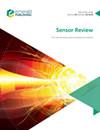Self-co-ordination algorithm (SCA) for multi-UAV systems using fair scheduling queue
IF 1.4
4区 工程技术
Q3 INSTRUMENTS & INSTRUMENTATION
引用次数: 2
Abstract
Purpose Data traffic through wireless communication is significantly increasing, resulting in the frequency of streaming applications as various formats and the evolution of the Internet of Things (IoT), such as virtual reality, edge device based transportation and surveillance systems. Growth in kind of applications resulted in increasing the scope of wireless communication and allocating a spectrum, as well as methods to decrease the intervention between nearby-located wireless links functioning on the same spectrum bands and hence to proliferation for the spectral efficiency. Recent advancement in drone technology has evolved quickly leading on board sensors with increased energy, storage, communication and processing capabilities. In future, the drone sensor networks will be more common and energy utilization will play a crucial role to maintain a fully functional network for the longest period of time. Envisioning the aerial drone network, this study proposes a robust high level design of algorithms for the drones (group coordination). The proposed design is validated with two algorithms using multiple drones consisting of various on-board sensors. In addition, this paper also discusses the challenges involved in designing solutions. The result obtained through proposed method outperforms the traditional techniques with the transfer rate of more than 3 MB for data transfer in the drone with coordination Design/methodology/approach Fair Scheduling Algorithm (FSA) using a queue is a distributed slot assignment algorithm. The FSA executes in rounds. The duration of each round is dynamic based upon the delay in the network. FSA prevents the collision by ensuring that none of the neighboring node gets the same slot. Nodes (Arivudainambi et al., 2019) which are separated by two or more hopes can get assigned in the same slot, thereby preventing the collision. To achieve fairness at the scheduling level, the FSA maintains four different states for each node as IDLE, REQUEST, GRANT and RELEASE. Findings A multi-unmanned aerial vehicle (UAV) system can operate in both centralized and decentralized manner. In a centralized system, the ground control system will take care of drone data collection, decisions on navigation, task updation, etc. In a decentralized system, the UAVs are unambiguously collaborating on various levels as mentioned in the centralized system to achieve the goal which is represented in Figure 2. Research limitations/implications However, the multi-UAVs are context aware in situations such as environmental observation, UAV–UAV communication and decision-making. Independent of whether operation is centralized or decentralized, this study relates the goals of the multi-UAVs are sensing, communication and coordination among other UAVs, etc. Figure 3 shows overall system architecture. Practical implications The individual events attempts in the UAV’s execution are required to complete the mission in superlative manner which affects in every multi UAV system. This multi UAV systems need to take a steady resolute on what way UAV has to travel and what they need to complete to face the critical situations in changing of environments with the uncertain information. This coordination algorithm has certain dimensions including events that they needs to resolute on, the information that they used to make a resolution, the resolute making algorithm, the degree of decentralization. In multi UAV systems, the coordinated events ranges from lower motion level. Originality/value This study has proposed a novel self-organizing coordination algorithm for multi-UAV systems. Further, the experimental results also confirm that is robust to form network at ease. The testbed for this simulation to sensing, communication, evaluation and networking. The algorithm coordination has to testbed with multi UAVs systems. The two scheduling techniques has been used to transfer the packets using done network. The self-organizing algorithm (SOA) with fair scheduling queue outperforms the weighted queue scheduling in the transfer rate with less loss and time lag. The results obtained through from Figure 10 clearly indicates that the fair queue scheduling with SOA have several advantages over weighted fair queue in different parameters.基于公平调度队列的多无人机系统自协调算法
目的通过无线通信的数据流量显著增加,导致流媒体应用程序以各种格式出现的频率和物联网(IoT)的发展,如虚拟现实、基于边缘设备的运输和监控系统。应用种类的增长导致了无线通信和频谱分配的范围的增加,以及减少在相同频带上工作的附近无线链路之间的干预的方法,从而导致频谱效率的提高。无人机技术的最新进展迅速发展,车载传感器具有更高的能量、存储、通信和处理能力。未来,无人机传感器网络将更加普遍,能源利用将在最长时间内维持一个功能齐全的网络方面发挥关键作用。考虑到空中无人机网络,本研究提出了一种稳健的无人机高级别算法设计(群组协调)。使用由各种机载传感器组成的多架无人机,用两种算法验证了所提出的设计。此外,本文还讨论了设计解决方案所涉及的挑战。通过所提出的方法获得的结果优于传统技术,在协调的无人机中数据传输的传输速率超过3MB。设计/方法/方法使用队列的公平调度算法(FSA)是一种分布式时隙分配算法。FSA分轮执行。每一轮的持续时间基于网络中的延迟是动态的。FSA通过确保没有任何相邻节点获得相同的插槽来防止冲突。被两个或多个希望分开的节点(Arivudainanbi et al.,2019)可以被分配到同一个插槽中,从而防止碰撞。为了实现调度级别的公平性,FSA为每个节点保持四种不同的状态,即IDLE、REQUEST、GRANT和RELEASE。因此,多无人飞行器(UAV)系统可以以集中和分散的方式运行。在集中式系统中,地面控制系统将负责无人机数据收集、导航决策、任务更新等。在分散式系统中,无人机在集中式系统所述的各个层面上明确协作,以实现图2所示的目标。研究局限性/含义然而,多无人机在环境观测、无人机通信和决策等情况下具有上下文感知能力。独立于操作是集中还是分散,本研究将多无人机的目标联系起来,即其他无人机之间的传感、通信和协调等。图3显示了整体系统架构。实际含义无人机执行中的单个事件尝试需要以最高级的方式完成任务,这影响到每个多无人机系统。这种多无人机系统需要对无人机必须以何种方式飞行以及需要完成什么来应对信息不确定的环境变化中的关键情况采取坚定的态度。这种协调算法具有一定的维度,包括他们需要决定的事件、他们用来制定决议的信息、决定制定算法、权力下放的程度。在多无人机系统中,协调事件的范围从较低的运动水平。原创性/价值本研究提出了一种新的多无人机系统自组织协调算法。此外,实验结果也证实了该方法的鲁棒性,可以很容易地形成网络。该模拟试验台用于传感、通信、评估和联网。算法协调必须在多无人机系统中进行测试。这两种调度技术已被用于使用done网络传输分组。具有公平调度队列的自组织算法(SOA)在传输速率方面优于加权队列调度,具有较小的损失和时滞。从图10中获得的结果清楚地表明,在不同参数下,SOA的公平队列调度比加权公平队列有几个优势。
本文章由计算机程序翻译,如有差异,请以英文原文为准。
求助全文
约1分钟内获得全文
求助全文
来源期刊

Sensor Review
工程技术-仪器仪表
CiteScore
3.40
自引率
6.20%
发文量
50
审稿时长
3.7 months
期刊介绍:
Sensor Review publishes peer reviewed state-of-the-art articles and specially commissioned technology reviews. Each issue of this multidisciplinary journal includes high quality original content covering all aspects of sensors and their applications, and reflecting the most interesting and strategically important research and development activities from around the world. Because of this, readers can stay at the very forefront of high technology sensor developments.
Emphasis is placed on detailed independent regular and review articles identifying the full range of sensors currently available for specific applications, as well as highlighting those areas of technology showing great potential for the future. The journal encourages authors to consider the practical and social implications of their articles.
All articles undergo a rigorous double-blind peer review process which involves an initial assessment of suitability of an article for the journal followed by sending it to, at least two reviewers in the field if deemed suitable.
Sensor Review’s coverage includes, but is not restricted to:
Mechanical sensors – position, displacement, proximity, velocity, acceleration, vibration, force, torque, pressure, and flow sensors
Electric and magnetic sensors – resistance, inductive, capacitive, piezoelectric, eddy-current, electromagnetic, photoelectric, and thermoelectric sensors
Temperature sensors, infrared sensors, humidity sensors
Optical, electro-optical and fibre-optic sensors and systems, photonic sensors
Biosensors, wearable and implantable sensors and systems, immunosensors
Gas and chemical sensors and systems, polymer sensors
Acoustic and ultrasonic sensors
Haptic sensors and devices
Smart and intelligent sensors and systems
Nanosensors, NEMS, MEMS, and BioMEMS
Quantum sensors
Sensor systems: sensor data fusion, signals, processing and interfacing, signal conditioning.
 求助内容:
求助内容: 应助结果提醒方式:
应助结果提醒方式:


